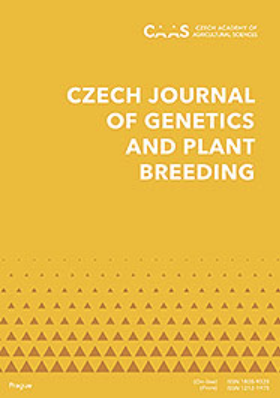基于落荚率和严重程度的大豆品系抗落荚性研究
IF 1.8
4区 农林科学
Q3 AGRONOMY
引用次数: 8
摘要
以大豆F8系为研究对象,从落荚率和落荚严重程度两方面评价其抗落荚性。材料包括14个F8大豆品系和2个对照品种。采用烘干法测定荚果破碎率,并根据荚果张开程度对荚果破碎程度进行评价。以落粒率为基础的抗落粒性有5个抗性品系(7-10%)、7个中等品系(13-23%)、1个易感品系(53%)和1个极易感品系(100%)。基于破碎严重程度的荚果抗破碎性表明,荚果腹侧开度在线与破碎程度之间存在差异,且在不同破碎程度下趋向于形成不同峰值位置的s型曲线。抗性、中等和敏感品系的破碎严重程度分别在60℃、50℃和40℃时达到峰值。荚果背侧长度(r = 0.827**)和腹侧长度(r = 0.880**)越长,荚果总重(0.827**)越大,籽粒大小(0.794**)越大,荚果易碎的程度越高。这些性状可作为大豆抗落荚性育种的选择标准。本文章由计算机程序翻译,如有差异,请以英文原文为准。
The pod shattering resistance of soybean lines based on the shattering incidence and severity
The study is aimed at evaluating the pod shattering resistance of F8 soybean lines based on the shattering incidence and shattering severity. The materials consist of fourteen F8 soybean lines and two check cultivars. The pod shattering incidence was examined by using the oven-dry method, meanwhile, the shattering severity was evaluated based on the severity of the pod opening. The pod shattering resistance based on the shattering incidence resulted in five resistant lines (7–10% shattering), seven moderate lines (13–23% shattering), one susceptible line (53% shattering), and one very susceptible line (100% shattering). The pod shattering resistance based on the shattering severity showed that the pod opening on the ventral side differed between the lines and between the shattering degree, and it tends to form sigmoid curves with a different peak position for each shattering degree. The shattering severity of the resistant, moderate, and susceptible lines reached a peak at 60 °C, 50 °C, and 40 °C, respectively. A longer pod length indicated by the length of the dorsal (r = 0.827**) and ventral (r = 0.880**) sides of the pod, a higher total pod weight (0.827**), and a larger seed size (0.794**) will increase the degree of susceptibility to pod shattering. Those characteristics were considered to be the ones that should be used as the selection criteria in the breeding programme for pod shattering resistance in soybeans.
求助全文
通过发布文献求助,成功后即可免费获取论文全文。
去求助
来源期刊

Czech Journal of Genetics and Plant Breeding
Agricultural and Biological Sciences-Plant Science
CiteScore
2.20
自引率
0.00%
发文量
25
审稿时长
>12 weeks
期刊介绍:
Original scientific papers, critical reviews articles and short communications from the field of theoretical and applied plant genetics, plant biotechnology and plant breeding. Papers are published in English.
 求助内容:
求助内容: 应助结果提醒方式:
应助结果提醒方式:


